Salton
Sea with Marguerite & Mark
Aug 31, 2003
Guides Bob Miller
Braving the heat for
a day of "hot" birds sightings!
85
species (list follows at end
of page)

Click on
thumbnail pictures for full-sized shots.
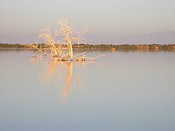
Salton Sea sunrise |
Sunrise near the New River Delta was outstanding
and the number of birds was impressive. |
| There had been a good hatch of Tilapia and the fish eating birds
were getting all they could. |
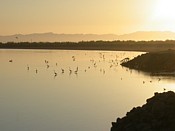
|
|

|
Large flocks of Red-necked Phalaropes were fun to
watch as they wheeled around in tight little groups over the
water. A flock is visible in this photo beyond the Snowy and
Great Egrets and this lone Great Blue Heron.
|
| We had Red-necked Phalaropes, American Avocet, Black-necked Stilt,
Forster's Terns and other birds passing right by us at eye level on
one of the protruding corners of the sea wall. |
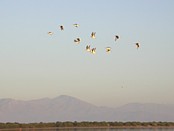
Red-necked Phalaropes
|
|
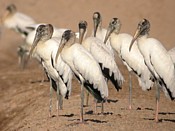
Wood Storks |

Wood Storks
|
| We came upon this group of 14 Wood Storks along the sea
wall. We found a lone bird a few miles further north.
As we were headed back into Calipatria, about noon, we had a flock
of seven Wood Storks gaining altitude and heading south over the
Alamo River. The remaining storks would probably be following them
within days.
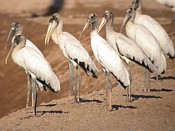
|
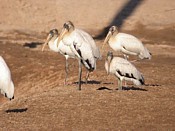
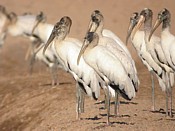
|
|
|
|
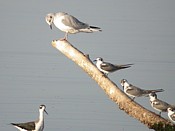
Variegated Meadowhawk
|
Bonaparte's Gulls were king of the hill on this snag but Black
Terns are content to be on the low perches or even on the shallow
rock outcroppings along this stretch of the Salton Sea. |
|
"Large-billed" Savannah Sparrows are
found where you would never think to look for Savannah
Sparrows! Among the rocks and concrete of the barren sea
wall right at the edge of the Salton Sea. We made a stop in
Calipatria for Bronzed Cowbird, Costa's Hummingbird
and others, then on to quick stops at the New River Wetlands
project sites before calling it a day.
|
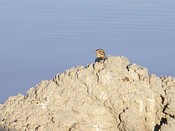
Going up!
|
|